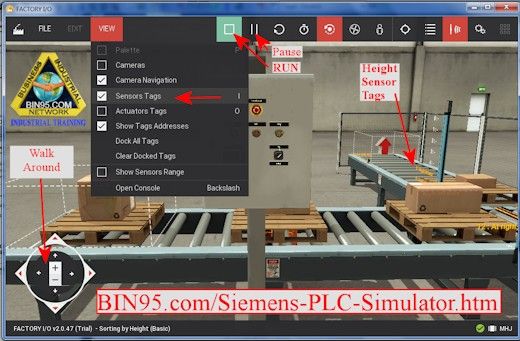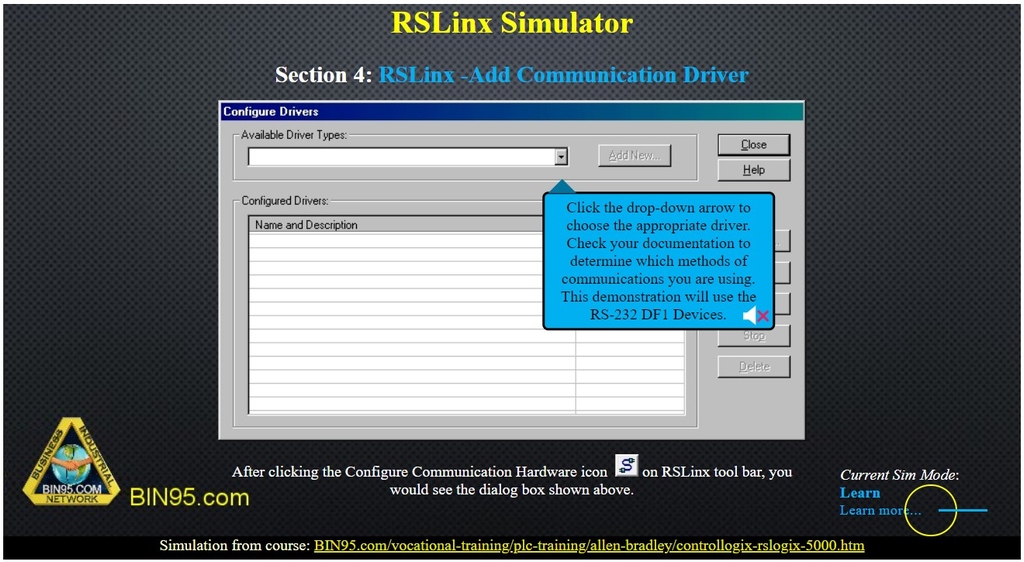Not Just Discrete Event PLC Simulation Software
- Home >
- articles >
- electrical >
- engineering >
- discrete event plc simulation
The Important Use of Simulation Software in Education

Below are several simulation software for education examples of use, followed by the 8 advantages of using simulations in education. Be sure to see many more examples using simulator software for technical vocational education by following the link at the end of this whitepaper.
Simulation-based learning no longer a novelty in undergraduate education.
The continuous innovation in the technology space has encouraged educational institutions and individuals to explore flexible learning opportunities outside the on-site classrooms. One option that is increasingly becoming popular for academic, professional, and technical training is eLearning simulation. More institutions are already offering a variety of online learning simulations that provide unique content via software simulation tools for training, online lectures, interactive discussion boards, and tutorials. Schools can actually bridge the learning gap between hands-on experience and theoretical learning in various technical training programs by leveraging eLearning simulation software. Undoubtedly, the use of simulation software in education is increasingly getting popular in different cities around the world.
What Exactly is Simulation Software?
Simulation software can either be an imagined system or a computerized model that is created to help teach people about how any given system works. Students who make use of simulation software are free to select tasks and the specific order in which they intend to complete them. Simulation comes in two different forms:
- Those that educate people about something such as physical simulation which enables users to manipulate a process or things on the screen.
- It could also be iterative simulations where several processes are slowed down or sped up to enable the user to watch as things unfold.
The second form of simulation has to do with the ones that teach how something is done. This includes:
- Procedural simulation which educates users on a sequence of steps needed to carry out some procedures.
- Also, it involves situational simulations that provide users with hypothetical situations or issues that they can react to.
Generally, simulations can serve as a supplement or even a replacement for role-playing, lab experiments, or field trips. College technical instructors or vocational teachers can leverage simulation software to clarify or introduce a topic and even foster exploration and process learning – both as a group or individual work. Remote learning for CTE/TVET programs is quite challenging and this is simply because their primary focus is on work readiness and practical skills. Interestingly, this is also one of the most remarkable benefits of making use of simulations in curriculum development. In a bid to meet the need for a more interactive and personalized educational experience for teachers and students, more educational software organizations both offline and online are now emerging with different solutions.
The Benefits of Using Simulation Software in Education
Several studies have over the years confirmed that simulations have helped to improve learning. However, it is crucial to add that the effectiveness of a simulation depends greatly on how accurate the simulation is. There are several benefits that schools and organizations can enjoy with the use of simulation software in education. Perhaps the most outstanding one is that it is a cost-effective solution for CTE/TVET Programs that desire to manage their students’ information and data in a more organized manner. But there are other significant benefits, and we shall be going through some of them now.
1: Interactive Simulations
The use of simulation software for education serves as a bridge between real-life experience and classroom learning. Simulation training helps students to use their current knowledge base and extend it via experiential trial and error. One of the most remarkable benefits of a simulation environment is that students can now enjoy a safe space for examining their strengths and weaknesses without the potential damage to expensive equipment that is associated with real-world situations. So, this interactive nature of online simulations allows students to enjoy unlimited time to carry out experiments and practice freely.
2: Enhances Practical Knowledge
Repetition as they always say is the key to task mastery and knowledge retention. So, the use of simulation software in education offers students the chance to continue to practice until they accomplish their goals. Since they can explore the outcomes of their actions, students can ascertain whether they may get a more favorable result by embracing an alternative path to learning. Also, they are free to repeat the challenging aspects of their training to fully understand the importance of each step and how all components work together. Students can enjoy the benefits of practical experience without being exposed to the risks associated with such training in the real world.
3: Environmental Benefits of Simulation Software
As the world battles to cut down on CO2 emissions, the use of simulation software in education will not only be cheaper (in terms of fuel savings) but will help to drastically reduce CO2 emissions. This even translates into some financial incentives or tax credits in some jurisdictions. Simulation training also implies that there wouldn't be the need to halt the use of revenue-generating equipment in a company just to make it available for training. Vocational teachers and college technical instructors will equally have more time to focus on several high-value-added tasks while students study with the simulator. The use of simulation software for technical training is undoubtedly a more efficient way to allocate resources in schools.
4: Enhanced Learning for Students
Generally, students or trainees tend to learn better from the mistakes they make while using a simulator. Simulation training is also an ideal solution for experienced operators intending to cross-train on other equipment. It is possible for the simulation software to flag various areas of concern during the technical training for special attention from vocational teachers and college technical instructors. This is because of the in-built tracking and scoring capabilities of the software.
5: Simulation Software Is Always Available 24/7
Sometimes, in physical classroom settings, college technical instructors may not be able to teach their students due to weather conditions or their health. However, the use of software simulation tools ensures their availability 24/7 throughout the year. This is extremely useful in colder climates where movement may be hindered during winter. This implies that students and trainees can now always make use of simulation tools. With software simulation tools, it would be possible to carry out team-based training with multiple signalers, operators, and machines working together virtually. In a real-life scenario, this type of technical training can be time-consuming, difficult, and expensive to coordinate.
6: Increased Safety Level with Simulation Software
Increased safety is undoubtedly one of the greatest benefits that students, vocational teachers, and college technical instructors enjoy with the use of simulation software in education. On a construction site or other locations where students get hands-on training with various equipment, accidents often occur. However, with simulation training, the chances of accidents happening are quite low. Simulation software has over the years been proven to reduce fatalities, the risk of injuries, and damage to property and equipment. The continuous development of simulation software has made it possible for them to help students develop skills that they can easily transfer to real equipment. Students get a head start (with less risk) in developing reliable, competent, and safe work site habits. Simulations also help to ensure that school training and curriculum development are standardized by tracking, measuring, and benchmarking their performance.
7: Employee & Student Assessments
Apart from using simulation software for training purposes, students can also take assessments too. This helps provide instant feedback regarding their activities and it also helps them to continuously learn and improve their knowledge and skills. According to the results of a study carried out by S. Jay Samuels and Yi-Chen Wu, immediate feedback is extremely effective not only in assisting students to understand the content but also in improving performance. The reason for this is that they can immediately identify their mistakes and learn from them.
In curriculum development, it is easy for the training materials of simulation software to be updated, developed, and modified. Training can take place anywhere, regardless of the place and time. This implies that the inability of students to gain access to physical training equipment will no longer be a problem as long as they have access to simulated equipment.
8: Training Simulation Software Is Very Cost-Effective
As mentioned earlier, the cost-effectiveness of simulation software is believed by many to be the most striking benefit of the use of simulation software in education. By using simulation software, the usual wear and tear on equipment that is often experienced during training will be drastically reduced. Of course, it is common knowledge that novice trainees or students are often hard on the machinery they are training on. But this is not the case with simulation training because the equipment will last longer, and it will help to reduce the frequency of repairs or replacement of machine parts. Although the acquisition of simulation software may be expensive initially, the benefits over time will justify the initial cost of purchasing them.
Considering the fact that simulation training allows students to learn and experiment in a controlled and safe environment, it protects them from causing harm to themselves and also expensive equipment. Another reason why they are cost-effective is that they are reusable and since there is no need for physical equipment, the cost of courses and programs is reduced.

Discrete Event Simulation Development Cost Case Study:
Simulation development in course software is typically much more cost-effective than online course simulations.
The picture above is a screenshot of a free online course simulation in our article on RSLinx PLC Communication. You can try it there at no cost, no registration is needed.
In considering converting our automation course software titles to online courses with the same capabilities and effectiveness, we duplicated a few of the 63 simulations in our RSLogix 5000 Course Software into an online format (HTML/JS). We wanted to know first if it is possible, and second what is the simulation development cost comparison. We found as you will experience at the link above that yes, it is possible.
Note: Discrete event simulation (DES) is a method of simulating the behavior and performance of a real-life process, facility, or system and is what we are duplicating in this case study.
Unfortunately, the cost just to duplicate the discrete event simulations was 60% higher than it cost to do the same in our training software. Twice that increase in development cost for us to add gamification to result in the final product you experienced at the link above. Surely the increased cost of creating simulations with the same user experience, compatibility, and reliability as simulation software is the key reason why most online courses are basically PowerPoint slides and questions with no interactive simulations. Our conclusion in this one case study was that the cost to convert all 63 discrete event simulations in just that one course would drive the cost of the course so high, most could not justify purchasing it. Thus to provide the best for less, we will continue to use the software as our training platform.
Conclusion
The truth is that while technology continues to evolve, several tools for education have also been evolving. By utilizing simulation software, vocational teachers and college technical instructors will significantly enhance and enrich the learning experience of students. The advantages of using simulation software range from helping students to be more experimentative in a safe environment and assisting in bridging the gap between practical applications and theoretical knowledge. The combination of all these factors can lead to the effective and proper training of students for their various industries.
There is no doubt that as we continue to witness an increase in technological advancement; the use of simulation software in education will keep increasing as it provides immersive and realistic training scenarios, and this will make them even more inexpensive and indispensable education tools. Remember, you need the right e-learning vendor that utilizes excellent authoring tools in creating a simulation that makes technical training interesting and smooth. Go ahead and visit Business Industrial Network to explore the numerous simulation software for education examples such as the PLC simulators and several others.
About the Author:
Don Fitchett is the President of BIN95's Industrial Training Company. Don also founded the activity based costing system called "True Downtime Cost ™ " (TDC), authored books, and speaks at conventions on the topic. Don has been in the industrial training sector for over three decades, setting up training programs around the world.
Sources:
Business Industrial Network (2022, October 8). Distance Learning Training Simulators.
Bloggers, C. I. (2019, April 15). Benefits of Software Simulations in E-learning.
CM Labs Simulations Inc. (2021, July 5). 6 benefits of training with simulators.
Nagatha, S. (2017, March 10). What You Need To Know About Educational Software.

